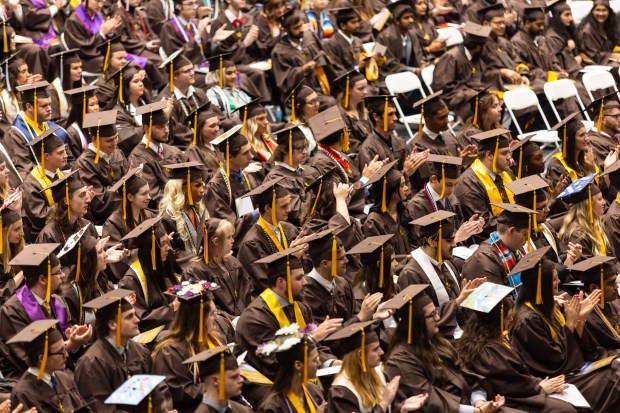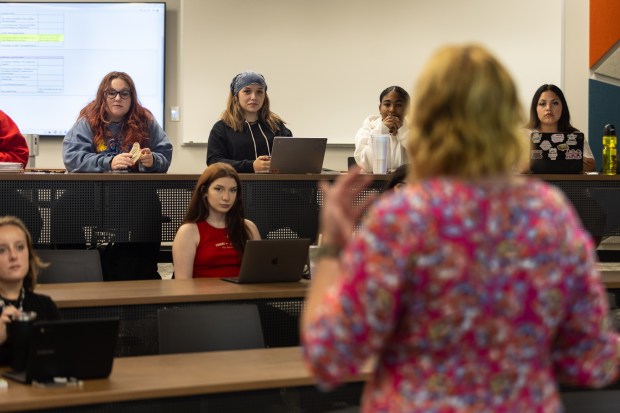As Valparaiso University implements an assortment of programs to boost enrollment, including partnerships with community colleges here and in Chicago, its fall enrollment continues to dip, though a university administrator expects the programs to begin yielding results in the next academic year.
The fall and new student headcount have both dropped in the past two years after numbers began to climb slightly in 2022, as the direct impact of the brunt of the COVID-19 pandemic began to wane. Still, according to enrollment figures on the university’s website, both numbers are below where they were in the fall of 2019 before the pandemic began.
The university had 852 new students in August, compared to 1,004 five years ago. Likewise, this year’s total fall headcount was 2,598 students, compared to 3,521 in fall 2019. Only 16 students from the latter count were in the university’s law school, its last cohort before it closed.
“We are committed to providing some stability to the university, so you can feel that in the community,” said Jill Schur, the university’s vice president for enrollment and marketing. “There’s lots of good work here. I know people are impatient.
Adding to the challenge, Schur said, were delays with the Free Application for Federal Student Aid, or FAFSA, for this academic year, after a new application rollout last winter that, according to a report late last month from the federal Government Accountability Office, began three months late and was full of technical glitches.
“Delays, glitches, and other issues led to a 9% decline in submitted FAFSA applications among first-time applicants, and an overall decline of about 432,000 applications as of the end of August,” the report states.
The FAFSA delays particularly hit applicants to the university’s Access College, a two-year associate degree program started as a pilot two years ago, geared for incoming students who need additional support as they begin their college careers. It was created to open the college experience to a greater number of students while providing those students a direct path to a four-year degree if they so choose.
Students in Valparaiso University’s Access College attend the class The Human Experience: Empathy and Dialogue and listen to Professor Chloe Kiser at Valparaiso University, in Valparaiso on Friday, Sept. 1, 2023. (Vincent D. Johnson/for the Post-Tribune).
Five students participated in the program’s “soft launch,” Schur said, with 25 students last year, and 17 students this year.
“Once we knew in the late fall that the FAFSA would be so delayed, that was particularly troubling for Access College students,” Schur said. “Seventeen was a particularly strong number given where the cycle put us.”
Anecdotally, Schur said the FAFSA snafus, which are expected to be a challenge during the coming application process as well, meant students had to wait longer to apply for aid, pushing back when they found out about financial aid packages from the schools they applied to and ultimately, their decision on where to attend.
“It was really challenging,” Schur said, adding students who didn’t enroll at VU took a gap year and may enroll in the spring. “We’re hoping those students want to continue their education in some capacity.”
State schools fared better this fall, she said, because they have lower tuition and were able to make those financial commitments to students.
The university hopes to see 20 students enroll in the Access College next fall, Schur said, adding officials “want to be realistic about projections” and also are hoping private donors can offset any FAFSA challenges and for prospective students, “that will ease their worries.”
In addition to the Access College, Valparaiso University and City Colleges of Chicago inked a guaranteed admissions agreement in July that could add more diversity at the Lutheran institution.
In April, VU and Ivy Tech Community College entered into a dual admission partnership agreement for students who receive an associate degree from Ivy Tech to seamlessly transfer to VU. They may also qualify for a Valpo transfer scholarship of $23,000 per year.
Those partnerships, Schur said, will begin to yield results in the coming years.
“Those will impact, at the earliest, the fall of 2025 transfer students and I’d estimate a handful, five to 10 at most, but right now we’re recruiting not only City College but high school students,” she said. “And the same for students in Indiana who have the ability to attend or are interested in attending Ivy Tech.”

Nationally, the number of students enrolling in college was already on the decline before the pandemic, according to statistics on the Education Data Initiative website, educationdata.org. The site focuses on research and resources tackling the rising costs of education.
Historic college enrollment for both graduate and undergraduate programs peaked in 2010 with 21 million students, according to the website. By 2022, the most recent year for which data was available, that number had dropped to 18.6 million, after a decade of steady decline.
José Padilla, Valparaiso University’s president, has said a “demographic cliff” has been predicted to hit by 2026, with a significant drop in the percentage of young adults ages 18 to 24 attending college, particularly in the Midwest and the Northeast.
Additionally, Padilla has said the whole dynamic of higher education has changed, with the COVID-19 pandemic bringing those changes to the surface. The percentage of Indiana students attending college dropped from 65% in 2015 to 53% seven years later.
“It’s complicated because we’re looking at the same data as colleges nationally,” Schur said, as the university figures out the right mix and number of students it can best serve.
The university is focusing on its strengths as it works to recruit more students, including its nursing and healthcare programs, she said, and while overall enrollment may be declining, there have been some highlights.
She cited a 20% increase in domestic graduates, which is helping offset a decrease in international students, and the university’s bid to become a Hispanic Serving Institution, which would both broaden the school’s student diversity and make it eligible for additional funding.
The university’s Hispanic population is 13%, representing a 19% increase, Schur said; the university needs 25% of its full-time equivalent student body to be Hispanic to qualify as an HSI.
“There are lots of bright spots in there despite that overall headcount,” she said.
University officials also have said that dorm renovations that include a gallery space, funded with the expected sale of three cornerstone pieces of artwork from the Brauer Museum, could help lure new students.
Schur said she can’t provide a formula used by the university to predict how dorm upgrades would impact enrollment for first-year students but the dorms were one of the reasons some students chose not to enroll at the university.
“It is part of their consideration when they’re deciding where to enroll,” she said.
alavalley@chicagotribune.com



